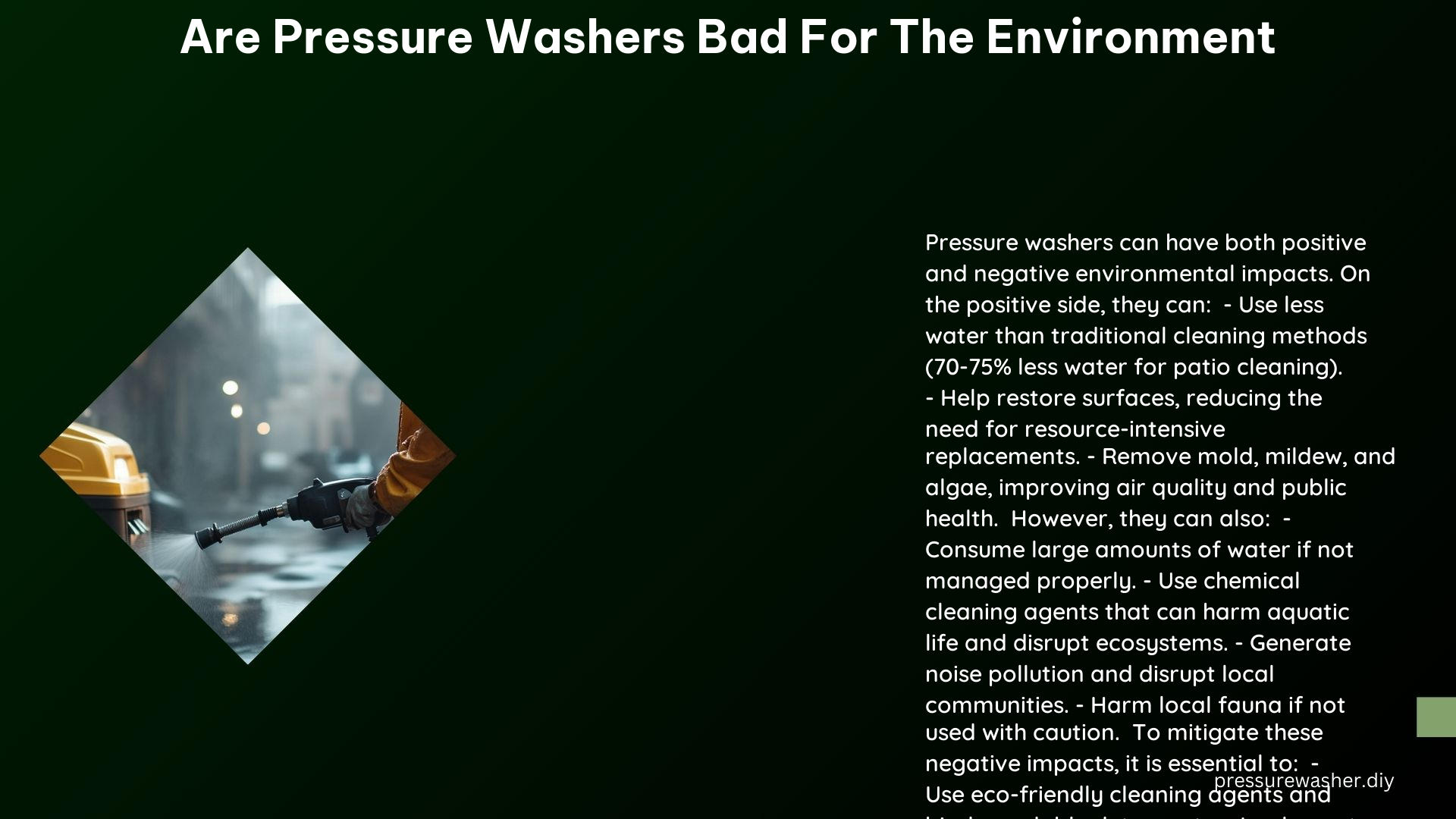Pressure washers are a popular tool for cleaning various surfaces, from driveways and sidewalks to buildings and vehicles. While they can be highly effective, there are both positive and negative environmental impacts to consider when using these powerful cleaning devices. In this comprehensive guide, we’ll dive deep into the technical details and best practices to ensure eco-friendly pressure washing.
Negative Impacts of Pressure Washers on the Environment
Excessive Water Usage
Pressure washers are known for their high water consumption, with some models capable of using up to 4 gallons of water per minute. This can quickly add up, especially during extended cleaning sessions, leading to significant strain on local water resources. According to a study by the University of North Carolina, a typical pressure washing job can use between 50 to 100 gallons of water.
To put this into perspective, a standard garden hose typically uses around 5-10 gallons per minute, meaning pressure washers can use up to 8 times more water. This excessive water usage can contribute to water scarcity, especially in areas with limited water supplies or during periods of drought.
Chemical Agents and Pollution
Many pressure washing tasks rely on the use of cleaning solutions and detergents, which can contain a variety of harmful chemicals. These chemicals, such as phosphates, surfactants, and solvents, can be highly toxic to aquatic life and disrupt the delicate balance of local ecosystems if washed into nearby waterways.
A study by the UAMCC (United Association of Master Contractors) found that pressure washing wastewater can contain high levels of pollutants, including heavy metals, oil, and grease. If this contaminated water is not properly contained and disposed of, it can have a devastating impact on the environment, harming fish, plants, and other wildlife.
Noise Pollution
Pressure washers are known for their loud and disruptive noise levels, which can range from 80 to 100 decibels (dB) at the operator’s position. This level of noise can be harmful to human health, causing stress, hearing damage, and disrupting the peace of local communities.
According to the World Health Organization, prolonged exposure to noise levels above 45 dB can have adverse effects on human health, including sleep disturbance and cognitive impairment. The high noise levels generated by pressure washers can be particularly problematic in residential areas or near sensitive environments, such as hospitals or schools.
Impact on Local Fauna
The powerful water stream and chemical agents used in pressure washing can have a significant impact on local wildlife and their habitats. The forceful water can disrupt or even destroy the delicate ecosystems of small insects, amphibians, and other small animals that may live in the areas being cleaned.
A study by the RTK Environmental Group found that the high-pressure water and chemical runoff from pressure washing can harm or displace local fauna, including birds, small mammals, and aquatic life. This disruption can have cascading effects on the broader ecosystem, potentially leading to a decline in biodiversity and the overall health of the local environment.
Positive Impacts of Pressure Washers on the Environment

Efficient Cleaning and Water Conservation
While pressure washers can consume significant amounts of water, they can also be more efficient than other cleaning methods in certain situations. Compared to manual scrubbing or using a garden hose, pressure washing can clean large surfaces more quickly, potentially reducing the overall water usage.
A study by Advantage Pro Services found that pressure washing can use up to 75% less water than traditional cleaning methods, as the high-pressure water stream is more effective at removing dirt and grime. This efficiency can translate to water savings, especially when cleaning large areas or surfaces that would otherwise require extensive manual labor.
Restoration and Conservation of Resources
Pressure washing can play a role in the restoration and conservation of various materials and surfaces, reducing the need for replacement and the depletion of natural resources. By effectively cleaning and reviving old or dirty items, pressure washing can extend the lifespan of these materials, preventing them from ending up in landfills or requiring the extraction of new raw materials.
For example, pressure washing can be used to clean and restore the appearance of outdoor furniture, fences, and even building facades, allowing these items to be reused and maintained rather than replaced. This can have a positive impact on the environment by reducing waste and the demand for new products.
Reduced Chemical Usage with Eco-Friendly Techniques
Advancements in pressure washing technology and the availability of eco-friendly cleaning agents have led to the development of more environmentally friendly pressure washing techniques. By using biodegradable detergents and minimizing the use of harsh chemicals, pressure washing can be performed in a way that reduces the impact on local ecosystems and waterways.
A study by Washh found that the use of eco-friendly pressure washing techniques, such as the use of plant-based or citrus-based cleaners, can significantly reduce the environmental impact of pressure washing. These alternative cleaning agents are often less toxic, more biodegradable, and less likely to harm aquatic life or disrupt the local environment.
Best Practices for Eco-Friendly Pressure Washing
To mitigate the negative environmental impacts of pressure washing, it’s essential to adopt a set of best practices. These practices can help conserve water, reduce chemical usage, and minimize the overall environmental footprint of pressure washing activities.
1. Choose Safe Cleaning Agents
When selecting cleaning agents for pressure washing, opt for biodegradable and eco-friendly detergents that are free of harmful chemicals, such as phosphates, solvents, and harsh surfactants. Look for products that are specifically designed to be environmentally friendly and safe for use near waterways and sensitive ecosystems.
2. Conserve Water
Implement water-saving techniques to reduce the overall water consumption of your pressure washing activities. This can include using pulse mode, adjusting the nozzle settings to optimize water flow, and pre-soaking surfaces to minimize the amount of water needed for cleaning.
3. Maintain Equipment Regularly
Regular maintenance and inspection of your pressure washing equipment can help ensure optimal efficiency and minimize water wastage. Clean the nozzles, check for any leaks or malfunctions, and replace worn parts to maintain the equipment’s performance and reduce unnecessary water usage.
4. Control Runoff and Wastewater
Implement measures to capture and redirect the water runoff and wastewater generated during pressure washing. This can involve using containment systems, such as tarps or temporary berms, to prevent the contaminated water from entering storm drains or local waterways. Properly dispose of the collected wastewater in accordance with local regulations.
5. Educate Yourself and Others
Stay informed about the latest eco-friendly pressure washing techniques, products, and regulations. Continuously educate yourself and share your knowledge with others, including clients and fellow pressure washing professionals, to promote the adoption of environmentally responsible practices within the industry.
Regulations and Guidelines for Eco-Friendly Pressure Washing
To ensure compliance with environmental regulations and minimize the impact of pressure washing activities, it’s essential to be aware of the relevant laws and guidelines in your local area.
Local Laws and Permits
Familiarize yourself with the local laws and regulations regarding wastewater discharge, stormwater management, and environmental protection. In many areas, pressure washing activities may require specific permits or approvals, such as NPDES (National Pollutant Discharge Elimination System) permits, to ensure proper handling and disposal of wastewater.
NPDES Permits and Guidelines
The NPDES program, established under the Clean Water Act, regulates the discharge of pollutants into U.S. waters. If your pressure washing activities involve the discharge of wastewater into local waterways, you may need to obtain an NPDES permit. These permits typically include guidelines for monitoring and limiting the amount of pollutants in the discharged water, ensuring the protection of aquatic ecosystems.
Technical Specifications and Considerations
To better understand the environmental impact of pressure washers, it’s important to consider the technical specifications and performance characteristics of these devices.
Water Usage
As mentioned earlier, pressure washers can consume significant amounts of water, with some models capable of using up to 4 gallons per minute. The water usage can vary depending on factors such as the pressure setting, nozzle size, and the specific cleaning task at hand.
Noise Levels
Pressure washers are known for their high noise levels, which can range from 80 to 100 decibels (dB) at the operator’s position. This level of noise can be disruptive to nearby residents and potentially harmful to human health, especially with prolonged exposure.
Chemical Composition of Cleaning Agents
When selecting cleaning agents for pressure washing, it’s crucial to choose eco-friendly and biodegradable products that are free of harmful chemicals, such as phosphates, solvents, and harsh surfactants. These alternative cleaning agents can help minimize the environmental impact of pressure washing activities.
Conclusion
Pressure washers can have both positive and negative impacts on the environment, and it’s essential to understand these implications to make informed decisions and adopt eco-friendly practices. By implementing the best practices outlined in this guide, pressure washing professionals and homeowners can significantly reduce the environmental footprint of their cleaning activities, conserve natural resources, and protect local ecosystems.
References
- UNC EHS. (n.d.). Pollution Prevention During Pressure Washing. Retrieved from https://ehs.unc.edu/topics/stormwater/pollution-prevention/pressure-washing/
- UAMCC. (2013). Environmental Law for Pressure Washers – The Clean Water Act. Retrieved from https://forum.uamcc.org/index.php?threads/environmental-law-for-pressure-washers-the-clean-water-act-what-the-heck-is-it.7246/
- RTK Environmental Group. (n.d.). The Dark Side of Pressure Washing. Retrieved from https://rtkenvironmental.com/healthy-home/the-dark-side-of-pressure-washing/
- Advantage Pro Services. (2023). The Environmental Impact of Pressure Washing. Retrieved from https://advantageproservices.com/blog/the-environmental-impact-of-pressure-washing/
- Washh. (2019). 7 Reasons to Go for Environmentally Friendly Pressure Washing. Retrieved from https://washh.com/washh-resources/environmentally-friendly-pressure-washing/
